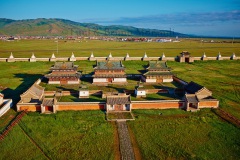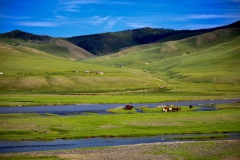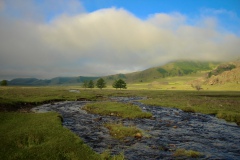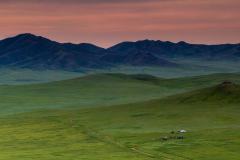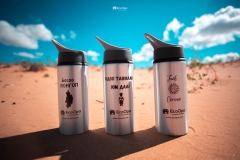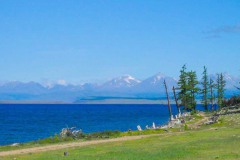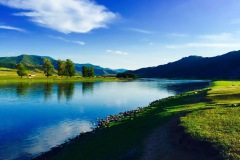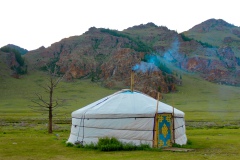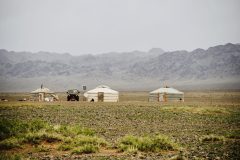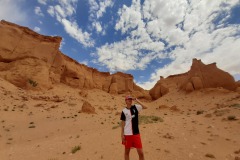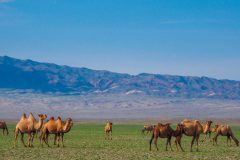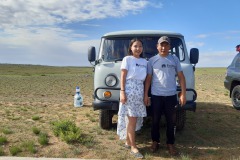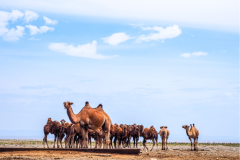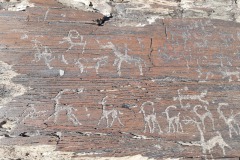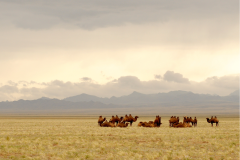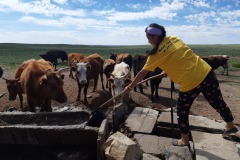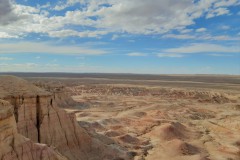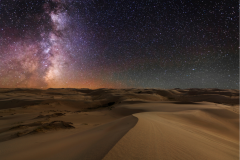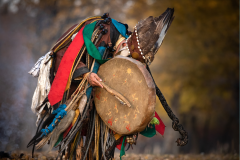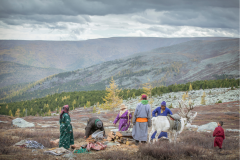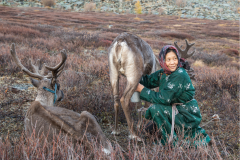16 days
Itinerary
Day 1: Baga gazriin chuluu 270 km
We can enjoy exploring this big granite stone massif in southern Mongolia in the first day. Baga gazriin chuluu is 300 square kilometers of big granite stone massif. Many historical and valuable items were found here, such as rock paintings, burial mounds, and evidence of other rituals.
Day 2: White stupa 240 km
Millions of years ago, the White stupa was an ancient seabed, which is now famous for its gorgeous and colorful slopes. The name “White Stupa” is originated because the rock formation looks like a palace, or row of stupas from a distance.
Day 3: Yol valley 210 km
It is a narrow gorge surrounded by rocky cliffs. Once we get to the gorge, we will hike about 2km on either side of the valley, totaling 4 km. In this area, most of steep rock walls see little sun light, therefore walking through the gorge will be refreshing compared to the hot Gobi sun.
Day 4: Khongor sand dune 210 km
Although the Khongor sand dune isn’t exceptionally tall, (less than 200m), climbing will take more than an hour because of how slippery it is. This is an absolutely thrilling and unique experience.
Day 5: Bayanzag and Flaming Cliffs 150 km
We will visit a small forest of saxual trees. Saxaul trees are native to the Gobi, growing with only a small amount of water. Close to the small forest of trees, there is a famous paleontological site: Flaming Cliffs, which refers to the sandstone’s beautiful orange and red color (especially during sunset). In the 1920s, an American expedition, led by Roy Chapman Andrews, worked in the Gobi, and they found the first fossilized dinosaur egg in the Flaming Cliffs.
Day 6: Ongi monastery ruin 170 km
It is our last day in the Gobi before heading back to Central Mongolia. This day, we will see the ruins of the old monastery, which was home of over a thousand monks. This famous monastery was almost completely destroyed by the communist purges in the 1930s. However, many visitors comment about the indescribable energy and feeling the ruins give off, therefore many people like to hike and meditate in the area.
Day 7: Kharkhorin / Kharkhorum 260 km
Due to the long day of traveling on dirt road, we will leave the camp earlier this day. On this day, we will drive to Kharkhorin town, where the Mongol Empire’s capital- Kharkhorum was existed! Upon arriving, we will go to both the Kharkhorum museum and Erdenezuu monastery. The Kharkhorum museum contains amazing displays of archeological finds from the Orkhon Valley area, which is listed on the World Heritage site by UNESCO. We will learn exciting historical facts and see ancient artifacts in this museum.
Erdenezuu is the first Buddhist Monastery in Mongolia, founded in 1586. Even though the monastery construction began in the 16th century, Erdenezuu was originally built with ruins of Kharkhorum city (13th century), making it over 800 years old!
Day 8: Ulaan tsutgalan waterfall 150 km
Ulaan Tsutgalan waterfall is the largest waterfall in Mongolia, attracting travelers for centuries! The waterfall is 24 meters high and 5 meters wide, a gorgeous display of mother nature’s power. This waterfall played a pivotal role in Mongolian history. When the National Revolutionary Army of China occupied Mongolia in 1919-1920, many Mongolian soldiers were saved because many Chinese troops drowned in the waterfall. After exploring this delightful area, we will stay with a local nomad family.
Day 9: Tsenkher hot spring 150 km
Tsenkher Hot Spring is the second hottest spring in Mongolia, with 85.5 celsius degree water. This alkaline spring contains sodium carbonate, hydrocarbonate, sulfate, fluorite, and hydrogen sulfide. This combination makes the spring ideal for treating rheumatism, neuralgia, muscular pain and arthralgia, it improves the digestive system, and restores immunity after surgery, in addition to general recharging of your body’s systems. Our tourist camp offers us the opportunity to enjoy bathing in the hot spring between the beautiful forested hills.
Day 10 & 11: Tariat – Terkhiin Tsagaan Lake & Khorgo volcano 200 km
Khorgo-Terkhiin Tsagaan Lake National Park is located in Tariat soum of Arkhangai province. Khorgo is an extinct volcano with a 200m tall crater. While driving into the national park, and climbing to the crater, you will notice black volcanic rocks strewn about. These rocks are littered throughout the area and are from the volcano blowing up over 9,000 years ago. Terkhiin Tsagaan Lake lies only 6 km from the Khorgo volcano. A peaceful and relaxing environment, it’s great for bird watching, exploring rock formations, hiking, and horse-riding.
Day 12: Shine-Ider town 160 km
On the way to Khuvsgul Lake, we will stay overnight at ger camp in Shine-Ider town. You can enjoy green nature and make some hiking yourself.
Day 13 & 14: Khuvsgul Lake 230 km
After having breakfast, we will drive to Khatgal town for Khuvsgul Lake. Khuvsgul is the largest lake in Mongolia (136 km length, 36.5 km wide, and up to 260 m deep) by volume with holding 2% of the world’s fresh water. The lake is well-known as the “Blue pearl” due to its clear water with deep blue view. Khuvsgul lake surroundings consist of rugged mountains, stunning rivers, and thick forest, which reminds Siberian view. Fishing, swimming, hiking, and horse-riding are the main activities in here.
Day 15: Uran togoo 300 km
This extinct volcano was once active 20 to 25 millions of years ago. The crater is 500 meters in diameter and 50 meters deep. A hike along a footpath through the Siberian larches (trees) will lead you to the crater. The area is a beautiful example of where the rolling grasslands meet the foothills of the Khangai Mountains. We will go to the bottom of the crater, where we will find a small lake and lush ecosystem. The volcano provides an environment supportive of sparrows, owls, falcons, red deer, wild sheep, ibex, marmots, and steppe rabbits.
Day 17: Drive back to UB 350 km
Check-in to your hotel.
Prices:
1 pax
2-4 pax
5-10 pax
€ 4210
€ 3580
€ 3040
Includes:
- Driver and guide
- Ger camps and nomad family stay
- All meals (B/L/D)
- Transportation
- National parks entrance fees
- Non-plastic water bottle and water
- Insurance
Not included:
- Personal expenses
- Optional activities (horse and camel riding etc.)
- Camera fees for museums and monasteries

